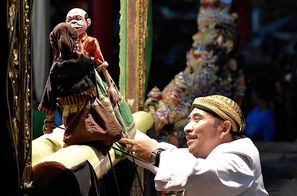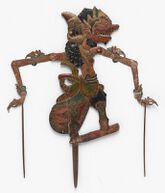Wayang Puppets: Difference between revisions
(Created page with "My name is Manuel and I am studying Directing and Neuroscience at St Levan / Great Britain.<br><br>Also visit my web-site Kometa web casino ([https://game-ss.ru/ game-ss.ru]) ") |
(Created page with "My name is Manuel and I am studying Directing and Neuroscience at St Levan / Great Britain.<br><br>Also visit my web-site Kometa web casino ([https://game-ss.ru/ game-ss.ru]) ") |
||
| Line 5: | Line 5: | ||
In the past, listening to a story is peoples favorite pastime that manifests the cultural and social condition of their society. The technique of the narrative and the content of the story also reflect the tradition and culture upheld by the population. There are many mass communication media that are used as a form of storytelling that brings a big impact toward the cultural and social development of the society. One of the earliest methods of storytelling is perhaps telling a story directly to the audience while facing each other. The method then evolves and integrate other elements of local and other nations tradition and culture, giving a birth to wayang. | In the past, listening to a story is peoples favorite pastime that manifests the cultural and social condition of their society. The technique of the narrative and the content of the story also reflect the tradition and culture upheld by the population. There are many mass communication media that are used as a form of storytelling that brings a big impact toward the cultural and social development of the society. One of the earliest methods of storytelling is perhaps telling a story directly to the audience while facing each other. The method then evolves and integrate other elements of local and other nations tradition and culture, giving a birth to wayang. | ||
[[File:Wayang klitik performance.jpg|thumb|left| | [[File:Wayang klitik performance.jpg|thumb|left|345x345px|''A Wayang Kulit performance'']] | ||
Wayang is an old form of storytelling that utilizes puppet figures to convey the story to the audience. Although the word wayang is the Javanese word for shadow, some of the types of wayang performance do not use the silhouette of the puppets. Many types of wayang performance, such as Wayang Kulit and Wayang Klitik, rely on the shadow of the puppets and the voice of dalang to deliver the story.<br> Traditionally, the performance uses an oil lamp or an electric bulb to cast the shadow of the puppets into a big white screen. However, some of the types of wayang do not use shadow to convey the story. For example, Wayang Wong uses actors in the performance, while Wayang Golek makes use of wooden puppets. Usually, the performance of wayang, when the dalang (puppet master) tells the story, is accompanied by nayaga (gamelan players) and sinden (female choral singer). Generally, the performance of wayang tells the story of classic Indian epics, such as Mahabharata and Ramayana, but nowadays many people also adapt other famous stories into wayang performance.<br> | Wayang is an old form of storytelling that utilizes puppet figures to convey the story to the audience. Although the word wayang is the Javanese word for shadow, some of the types of wayang performance do not use the silhouette of the puppets. Many types of wayang performance, such as Wayang Kulit and Wayang Klitik, rely on the shadow of the puppets and the voice of dalang to deliver the story.<br> Traditionally, the performance uses an oil lamp or an electric bulb to cast the shadow of the puppets into a big white screen. However, some of the types of wayang do not use shadow to convey the story. For example, Wayang Wong uses actors in the performance, while Wayang Golek makes use of wooden puppets. Usually, the performance of wayang, when the dalang (puppet master) tells the story, is accompanied by nayaga (gamelan players) and sinden (female choral singer). Generally, the performance of wayang tells the story of classic Indian epics, such as Mahabharata and Ramayana, but nowadays many people also adapt other famous stories into wayang performance.<br> | ||
[[File:Wayang golek performance.jpg|thumb| | [[File:Wayang golek performance.jpg|thumb|297x297px|''A Wayang Golek performance'']] | ||
'''Different types of wayang in Indonesia:''' | '''Different types of wayang in Indonesia:''' | ||
Revision as of 12:19, 12 September 2023
Wayang Puppets Content
Golek - Menak - Cepak - Kulit - Klitik - Other Wayang Puppets
Introduction to the Types of Wayang
In the past, listening to a story is peoples favorite pastime that manifests the cultural and social condition of their society. The technique of the narrative and the content of the story also reflect the tradition and culture upheld by the population. There are many mass communication media that are used as a form of storytelling that brings a big impact toward the cultural and social development of the society. One of the earliest methods of storytelling is perhaps telling a story directly to the audience while facing each other. The method then evolves and integrate other elements of local and other nations tradition and culture, giving a birth to wayang.
Wayang is an old form of storytelling that utilizes puppet figures to convey the story to the audience. Although the word wayang is the Javanese word for shadow, some of the types of wayang performance do not use the silhouette of the puppets. Many types of wayang performance, such as Wayang Kulit and Wayang Klitik, rely on the shadow of the puppets and the voice of dalang to deliver the story.
Traditionally, the performance uses an oil lamp or an electric bulb to cast the shadow of the puppets into a big white screen. However, some of the types of wayang do not use shadow to convey the story. For example, Wayang Wong uses actors in the performance, while Wayang Golek makes use of wooden puppets. Usually, the performance of wayang, when the dalang (puppet master) tells the story, is accompanied by nayaga (gamelan players) and sinden (female choral singer). Generally, the performance of wayang tells the story of classic Indian epics, such as Mahabharata and Ramayana, but nowadays many people also adapt other famous stories into wayang performance.
Different types of wayang in Indonesia:
- Wayang Kulit (wayang that is made of leather)
- Wayang Wong (wayang performance that is played by actors, instead of puppets)
- Wayang Gedog (similar to Wayang Wong, but the actors wear a mask)
- Wayang Golek (wayang that is made of wooden)
- Wayang Klitik (a small wayang that is made of wood)
- Wayang Beber (wayang performance that is told using scroll paintings)
While it is not as popular as before, the legacy of wayang influences Indonesian creative industry and many artists. People can find a lot of arts and crafts that take inspiration from wayang. The performance of wayang is also adapted into television shows and bring a great entertainment to Indonesian people. Even though the role of wayang as a storytelling media is gradually replaced by another modern medium, the heritage of wayang is still beating in peoples life.
Wayang Puppets
Puppets fall into two major classifications - wayang kulit - the leather or shadow puppet of Central Java, and wayang golek - wooden puppets of West Java. The most famous puppets of Indonesia are the carved leather wayang kulit puppets. The intricate lace figures are cut from buffalo hide with a sharp chisel-like stylus and the painted. They are produced on Bali and Java, particularly Central Java. The leaf-shaped kayon representing the “tree” or ‘mountain of life” is used to end scenes in the wayang ans is also made of leather. There are several varieties of wooden puppets. Wayang Golek are the three dimensional wooden puppets found in Central Java, but are most popular among the Sundanese of West Java.
The "Wayang klitik" puppets are a rarer flat wooden puppet of East Java. They are also known as a Krucil Gepeng puppet. Made of carved, gilded, and painted wood. The rods are made of horn with fibre tassels. The arms made of hide and the rods are attached with fibre. The main rod has been cut off at some point.
The “Wayang kulit” (leather puppets) of Java is performed with leather puppets held by the puppeteer (dalang), who narates the story of one of the famous episodes of the Hindu epics, the Mahabharata or the Ramayana. It is performed against a white screen while a lantern in the background casts the shadows of the characters on the screen, visible from the other side where the spectators are seated.
The “Wayang Golek” (wooden puppets) of West Java is based on the same concept. The crafts of Indonesia vary in both medium and art form. As a whole the people are artistic by nature and express themselves on canvas, wood, metals, clay and stone. The batik process of waxing and dyeing originated in Java centuries ago and classic designs have been modified with modern trends in both pattern and technology. There are several centres of Batik in Java, the major ones being Yogyakarta, Surakarta, Pekalongan and Cirebon.
Puppets have been used for centuries in Indonesia to tell the stories of the ancient epics, the Ramayana and the Wayang Kulit Mahabarata, as well as ancient myths. Modern stories also utilize this ancient art form for contemporary audiences. Some expats enjoy collecting the same character by various artisans, or all the characters in a scene or story, or just characters that strike their fancy. Good guys, bad guys, gods, demons, nobles, giants, clowns, princes and princesses and monkeys ... all can be found in traditional puppet forms.
More info
Wikipedia - Wayang




